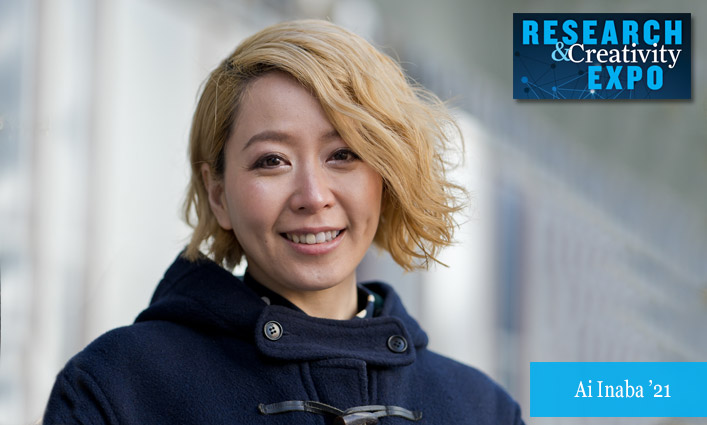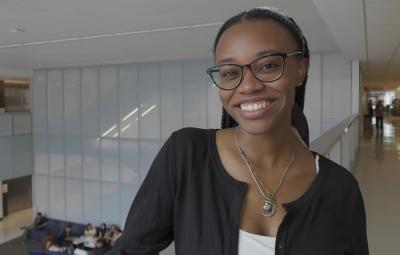
John Jay College deeply values the power of data. Research is an integral part of our institutional mission, and as a society, we rely on data to help guide our perspectives and policies. It’s this dedication to research that underpins our excitement about the 2021 Research & Creativity Expo, April 28 – May 7. At this annual event—which will be presented through a variety of online platforms due to the pandemic—we have the opportunity to see some of the research projects that our students have been working on for a semester, or even a full academic year, with the collaboration and guidance of our dedicated faculty. The students’ research projects cover a wide range of disciplines and methodologies, and they skillfully examine questions and concerns that directly impact our communities. In short: Our Research & Creativity Expo is a celebration of John Jay’s thriving research community.
If you’re not in the scientific community, and you’re not up on the latest measures being studied to combat terrorism and biological weapons, you might not know what ricin is, but Ai Inaba ’21 and Biochemistry Assistant Professor Artem V. Domashevskiy, Ph.D. have been spending a lot of time researching ways to prevent this deadly toxin from being used as a chemical/biological warfare agent. Historically, ricin, a plant toxin from the castor bean plant, has been implicated in several animal and human poisonings. “Our research project focuses on the development of a synthetic peptide that may be used as an efficient inhibitor against ricin,” says Inaba, a John Jay Rising Star Fellowship awardee and a scholar from the U.S.-Japan Council Watanabe Study Abroad Program. She further explains that “the castor bean plant employs the ricin toxin to defend itself from being eaten by animals, including humans.” We were thrilled to connect with Inaba to get a deeper dive into this important scientific research.
Your research with Professor Domashevskiy is truly fascinating. Can you talk a little more about the development of the peptide that could inhibit ricin?
Well, there’s a member of the genus Potyvirus, the turnip mosaic virus (TuMV), that is thought to have an evolutionary advantage that aids the virus in overcoming the plant defense mechanisms of some virus-resistant plants, such as pokeweed. The TuMV genome includes a small viral genome-linked protein (VPg) that binds to and inhibits the activities of these plant toxins, allowing the virus to promote its viral replication and infection cycle.
Professor Domashevskiy, my research advisor, has conducted the preliminary research and demonstrated that VPg inhibits the activity of ricin and similar toxins. My project involves investigations into the protein-protein interaction between VPg and a catalytic subunit of ricin (RTA) and includes the engineering of a VPg peptide that possesses an inhibitory effect on ricin toxin. The goal of our research is to develop an effective treatment against ricin poisoning. Our findings may lead to a design of novel therapeutics against ricin poisoning, and other related cytotoxic biological agents, like Shigella-like toxins.
“The goal of our research is to develop an effective treatment against ricin poisoning. Our findings may lead to a design of novel therapeutics against ricin poisoning, and other related cytotoxic biological agents.” —Ai Inaba
What was the research process like? What was your research methodology?
My research at Dr. Domashevskiy’s lab began with studying the history of ricin. I started reviewing existing literature, including Dr. Domashevskiy’s publications, to learn about ricin, VPg, and methods employed in our research. As a Program for Research Initiatives in Science and Math (PRISM) scholar, I had a head start attending numerous summer workshops, where I learned the principles of basic research techniques. Additionally, I have gained knowledge by reading scientific literature, interpreting research data, and conducting my own research. Throughout my studies, it was impressed upon me to never forget the impact science can have on society, including our own scientific community. Through PRISM, I have also learned how to write grant proposals. I have written my research proposal with the research aims and experimental procedures, which is currently happening remotely due to the ongoing pandemic. I have actively learned essential biochemistry techniques that are necessary for our research, so that we can jumpstart the experiments once we return to the laboratory.
“As a Program for Research Initiatives in Science and Math (PRISM) scholar, I had a head start attending numerous summer workshops, where I learned the principles of basic research techniques.” —Ai Inaba
Our research plan is to employ site-directed mutagenesis and create truncated VPg peptide variants that we hypothesize will have the greatest binding and inhibitory effect on ricin. Then, we will conduct a quantitative analysis of our results by using fluorescence assays and high-performance liquid chromatography separation to identify the VPg variant with the most efficient inhibitory activity on ricin. We will use molecular modeling and docking analysis and X-ray crystallography to solve the 3D structure of the ricin-VPg complex to study the interaction further.
Ultimately, we expect to create a VPg variant that has a minimum amino acid sequence, higher binding affinity and specificity, and greater inhibitory effect on ricin toxicity. The long-term goal of our proposed research is to develop a synthetic peptide that can be used as an optimal inhibitor of ricin toxin.
Was there a special professor that helped you in your research? How did they guide you and what were they particularly helpful with as you progressed in your research?
I cannot choose one since so many dedicated and amazing professors at John Jay guided me through my research project. However, I would still like to honor three special professors: my mentor Dr. Domashevskiy, and the PRISM co-directors Dr. Sanguineti, who I call “Dr. G,” and Dr. Sanabria-Valentín, “Dr. Ed,” who supported me throughout my research project.
Dr. Domashevskiy is the best mentor ever. He has not only taught me the techniques of biochemistry research, but also prepared me for my graduate studies, always making sure I understand every step and detail. I am so grateful for the mentorship he has given me. Dr. G guided me on how to write strong science proposals. I will never forget how glad I was when she told me that I did an excellent job on my statement and said, “It was a pleasure to read your research statement.” Her recognition of my effort made me feel that I was becoming a scientist. Dr. Ed always gave me helpful advice and cared about my success with the project. He works very hard to maximize the potential of his students. He was the one who believed in me, and I am so grateful to have him as my professor.
What were the most challenging aspects of conducting this research? What were the most rewarding aspects?
My research is highly interdisciplinary, involving biochemistry, molecular biology, virology, and pathogenesis. Understanding the principles of research and biochemical techniques without conducting actual experiments and generating the raw data was challenging. For the same reason, I faced difficulties many times when designing and establishing the strategies to answer the research questions without physically being exposed to the research in the laboratory. However, my mentor and the PRISM directors helped me to overcome all of them, and ultimately, I wrote my own research proposal.
“I faced difficulties many times when designing and establishing the strategies to answer the research questions without physically being exposed to the research in the laboratory. However, my mentor and the PRISM directors helped me to overcome all of them.” —Ai Inaba
With my posters and our preliminary data, I have attended various conferences and presented my future plan at the 2020 Biomedical Research Symposium at Icahn School of Medicine at Mount Sinai, the 2021 SACNAS New England Regional Conference hosted by Harvard University, and the 2021 PRISM Research Symposium. It was absolutely one of the most rewarding moments in my research to present my work and to have feedback provided to me on my oral presentations from professors at top research universities and to connect with many scientists from various fields.
As a college focused on justice, how does your research help move the needle forward on justice issues? How do you hope your research is used?
We are working on the development of a therapeutic peptide against plant toxin ricin that is recognized as a category B biological agent. Our mission is very important because our research will not only help design therapeutics to treat or prevent the poisoning, but most importantly, it will also help keep the toxin from being an attractive compound as a bioweapon. I hope my research is used to help develop novel and more effective treatments against ricin and other related toxins and ultimately provide an advanced strategy against the use of these deadly toxins as agents of bioterrorism, all of which will lead to making a safer environment.
In five years, what do you hope you’ll be doing?
In five years, I will be working on my dissertation to pursue my Ph.D. degree. In the future, I hope to become a university professor, conducting independent research and mentoring students from various backgrounds including minority, underrepresented groups, women, and international students.
“I made the best decision ever to attend John Jay College and will forever be proud of being a student and a graduate of John Jay College.” —Ai Inaba
Can you finish this sentence? Because of John Jay...
Because of John Jay and PRISM, I have been presented with invaluable opportunities to gain knowledge, critical research and problem-solving skills, and professional and personal development as a scientist. I have built great relationships with mentors and professors that I hope to keep for my lifetime. I made the best decision ever to attend John Jay College and will forever be proud of being a student and a graduate of John Jay College.



